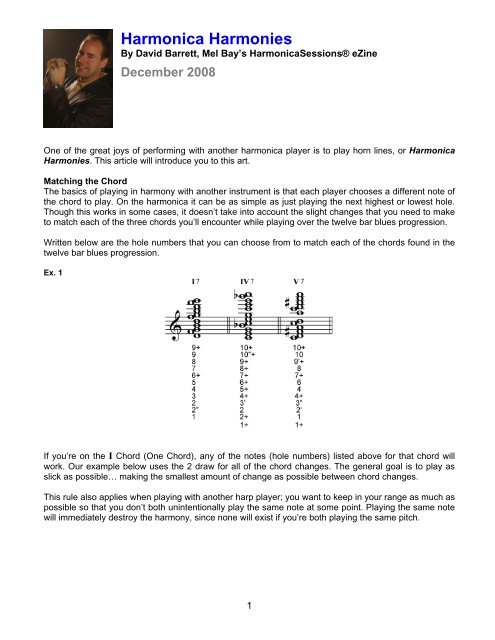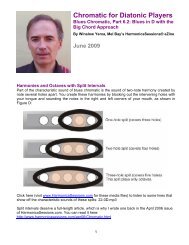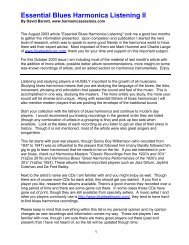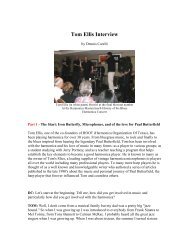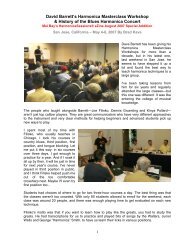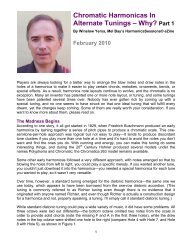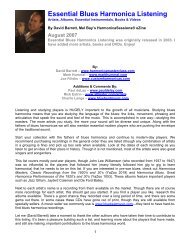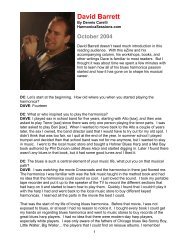Harmonica Harmonies - Mel Bay's Harmonica Sessions
Harmonica Harmonies - Mel Bay's Harmonica Sessions
Harmonica Harmonies - Mel Bay's Harmonica Sessions
You also want an ePaper? Increase the reach of your titles
YUMPU automatically turns print PDFs into web optimized ePapers that Google loves.
<strong>Harmonica</strong> <strong>Harmonies</strong><br />
By David Barrett, <strong>Mel</strong> Bay’s <strong>Harmonica</strong><strong>Sessions</strong>® eZine<br />
December 2008<br />
One of the great joys of performing with another harmonica player is to play horn lines, or <strong>Harmonica</strong><br />
<strong>Harmonies</strong>. This article will introduce you to this art.<br />
Matching the Chord<br />
The basics of playing in harmony with another instrument is that each player chooses a different note of<br />
the chord to play. On the harmonica it can be as simple as just playing the next highest or lowest hole.<br />
Though this works in some cases, it doesn’t take into account the slight changes that you need to make<br />
to match each of the three chords you’ll encounter while playing over the twelve bar blues progression.<br />
Written below are the hole numbers that you can choose from to match each of the chords found in the<br />
twelve bar blues progression.<br />
Ex. 1<br />
If you’re on the I Chord (One Chord), any of the notes (hole numbers) listed above for that chord will<br />
work. Our example below uses the 2 draw for all of the chord changes. The general goal is to play as<br />
slick as possible… making the smallest amount of change as possible between chord changes.<br />
This rule also applies when playing with another harp player; you want to keep in your range as much as<br />
possible so that you don’t both unintentionally play the same note at some point. Playing the same note<br />
will immediately destroy the harmony, since none will exist if you’re both playing the same pitch.<br />
1
Ex. 2<br />
You can still stay on the second hole but use the 2+ (2 blow) on the IV Chord to add a little more<br />
interest. This is demonstrated in Example 3 below.<br />
Ex. 3<br />
Harmonizing<br />
Examples 2 and 3 are good to play for general accompaniment. To play in harmony with these<br />
examples all you would need to do is to move up or down to the next hole on the harmonica. Example 4<br />
uses hole 3 as a focus. The 3 draw has the unique property of just needing to be bent a half step more<br />
each time a chord change comes. For the I Chord you’ll play the 3 draw unbent, or bent just slightly (a<br />
quartertone) for bluesy affect. For the IV Chord bend the 3 down a half step (3’). For the V Chord bend<br />
the 3 down a whole step (3”).<br />
Try playing Example 4 by itself to build mastery of the bends (making sure the bends are in tune). Then,<br />
play Example 4 on top of my recording of Example 3 to hear the harmony. You can do the same thing in<br />
reverse as well, Example 3 on top of my recording of Example 4 to hear the harmony.<br />
2
Ex. 4<br />
Self Harmonizing<br />
If we’re speaking of general harmonica accompaniment, keep in mind that whenever possible it’s a good<br />
idea to use octaves for a bigger sound. This can make it sound like there are two players, but you’re<br />
playing both parts (the single note in the left side of your mouth and the single note on the right side of<br />
your mouth). This is demonstrated in Example 5 below.<br />
Ex. 5<br />
Other Harmonizing Options<br />
If you’re taking a lick that you like and want to make a harmony part then you can use the same general<br />
rule as before… move the lick up or down one hole on the harmonica. Make sure to reference the notes<br />
in Example 1—these note choices will sound best when you have the option. Example 6 shows some<br />
more harmony options just in case you need a hipper harmony or just need some more note choices<br />
when the others don’t quite seem to work.<br />
3
Ex. 6<br />
Many times the lick you’re trying to harmonize will have notes that don’t fit in either chart. In that case<br />
you just need to experiment with other notes until you find something that sounds good. Make sure to<br />
also check all possible bend combinations—sometimes it’s a bend you wouldn’t expect to sound good<br />
that ends up making the harmony work.<br />
Song Example<br />
Our final example is an original instrumental I’ve written called “It Takes Three.” This is an example of<br />
the cool harmonies you can do if you spend the time it takes to find the right combination. If you see only<br />
one note written, it’s only player one playing. You’ll need a B-flat harmonica for this song.<br />
Ex. 7<br />
4
Ending<br />
About the Author David Barrett<br />
http://www.harmonicamasterclass.com/david.htm<br />
5


